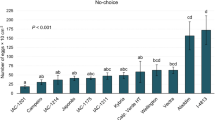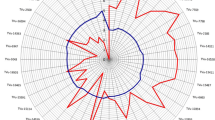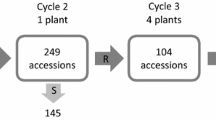Summary
Banana weevil (Cosmopolites sordidus Germar) is a major limiting factor in the cultivation of plantains and bananas (Musa spp. L.) in sub-Saharan Africa. The larvae damage the crop by tunneling in the corm. Chemical control is feasible but not sustainable, whereas host plant resistance is safe and has long term benefits. Banana weevil damage and infestation levels and corm hardness were assessed in Musa germplasm in order to determine the genetic control and potential mechanisms of resistance to this insect pest. Susceptibility/resistance to weevil was measured by the percentage coefficient of infestation (PCI) and damage in cross sections (CS) of the corm. All plantains were equally susceptible to the banana weevil, while a wild banana accession and some cooking and dessert banana cultivars showed high levels of resistance. Differential genotypic responses were observed in euploid plantain-banana hybrids. Segregation results suggest that host plant response to weevil in Musa is controlled by gene(s) exhibiting partial dominance towards the resistant parent and modifier genes with additive and dosage effects for susceptibility in the plantain parent. In natural banana germplasm, resistant clones showed increased corm hardness, as measured by a penetrometer in longitudinal and cross sections of outer and central corm tissues. This might suggest a non-preference mechanism for weevil resistance. However, the lack of correlation between corm hardness with PCI and CS scores in the segregating progenies suggested that other mechanisms may be more important in conferring resistance to banana weevil.
Similar content being viewed by others
References
Becker W.G., 1975. Manual on quantitative genetics, 3rd Ed. Washington State University Press, Pullman. 170 pp.
Belalcazar S.L., 1991. El cultivo del platano (Musa AAB Simmonds) en el tropico. Instituto Colombiano Agropecuario, Quindio, Colombia. 376 pp.
CRBP (Centre Régional Bananiers et Plantains), 1992. Rapport de synthèse, recherches 1991. Document Centre Régional Bananiers et Plantains, Douala, Cameroon.
Cuillé, J., 1950. Recherches sur le charançon du bananier. Inst. Fr. Agr. Col., Sér. Tech. 4: 225 pp.
Froggot J.L., 1925. The banana weevil borer. Queensl. Agric. J. 24: 558–593.
Haddad O., J.R. Surga & M. Wagner, 1979. Relacion de la composicion genomica de las Musaceas con el grado de attraccion de adultos y larvas de Cosmopolites sordidus G. (Coleop. Curculionidae). Agronomia Tropical 29: 429–438.
Ityeipe K., 1986. Studies on the host preference of banana weevil borer Cosmopolites sordidus Germ. (Coleoptera Curculionidae). Fruits 41: 375–379.
Koppenhöfer A.M., 1993. Observations on egg-laying begaviour of the banana weevil, Cosmopolites sordidus (Germar.). Entomol. exp. appl. 68: 187–192.
Mesquita A.L.M., E.J. Alves & R.C. Caldas, 1984. Resistance of banana cultivars to Cosmopolites sordidus (Germar, 1824). Fruits 39: 254–257.
Mitchell, G.A., 1978. The estimation of banana borer population and resistance levels. Winban Research & Development. Technical Bulletin No.2.
Neuenschwander P., 1988. Prospects and proposals for biological control of Cosmopolites sordidus Germar (Coleoptera Curculionidae) in Africa. p. 54–57. In: Nematodes and the Borer Weevil in Bananas. Proceedings of a workshop held in Bujumbura, Burundi, 7–11 December 1987. INIBAP, Montpellier, France.
Ogenga-Latigo M.W. & R. Bakyalire, 1993. Use of pseudostem traps and coefficient of infestation (PCI) for assessing banana infestation and damage by Cosmopolites sordidus. Afric. Crop Sci. 1: 31–38.
Ortiz R. & D. Vuylsteke, 1994a. Inheritance of black sigatoka resistance in plantain-banana (Musa spp.) hybrids. Theor. Appl. Genet., 89: 146–152.
Ortiz R. & D. Vuylsteke, 1994b. Genetics of apical dominance in plantain (Musa spp., AAB group) and improvement of suckering behavior. J. Am. Soc. Hort. Sci. 119: 1050–1053.
Ostmark H.E., 1974. Economic insect pests of bananas. Ann. Rev. Entomol. 19: 161–176.
Painter R.H., 1958. Resistance of plants to insects. Ann. Rev. Entomol. 3: 267–290.
Pavis C. & C. Minost, 1993. Banana resistance to the banana weevil borer Cosmopolites sordidus Germar (Coleoptera: Curculionidae): role of pseudostem attractivity and physical properties of the rhizome. p. 129–142. In: J. Ganry (Ed.) Breeding Banana and Plantain for Resistance to Diseases and Pests. CIRAD/INIBAP, Montpellier, France.
Roche R. & S. Abreu, 1983. Control del picudo negro del platano (Cosmopolites sordidus) por la hormiga Tetramorium guinieensis. Ciencias Agric. (Cuba) 17: 41–49.
Seshu-Reddy K.V. & M.C. Lubega, 1993. Evaluation of banana cultivars for resistance to/tolerance of the weevil Cosmopolites sordidus Germar. p. 143–148. In: J. Ganry (Ed.) Breeding Banana and Plantain for Resistance to Diseases and Pests. CIRAD/INIBAP, Montpellier, France.
Sikora R.A., N.D. Bafokuzara, A.S.S. Mbwana, G.W. Oloo, B. Uronu & K.V. Seshu-Reddy, 1989. Interrelationship between banana weevil, root lesion nematode and agronomic practices and their importance for banana decline in the United Republic of Tanzania. FAO Plant Protection Bulletin 37: 151–157.
Simmonds N.W., 1959. Bananas. Longmans, Green & Co. Ltd., London.
Smith C.M., 1989. Plant resistance to insects. John Wiley and Sons, Inc., New York.
Stern C., 1929. Uber die additive Wirkung multipler Allele. Biol. Zbl. 49: 261.
Stover R.H. & N.W. Simmonds, 1987. Bananas, 3rd Ed. Longman Scientific & Technical, Essex, UK.
Vakili N.G., 1968. Responses of Musa acuminata species and edible banana cultivars to infection by Mycosphaerella musicola. Trop. Agric. (Trinidad) 45: 13–22.
Vilardebo A., 1973. Le coefficient d'infestation, critère d'évaluation du degré d'attaques des bananeraies par Cosmopolites sordidus Germ., le charançon noir du bananier. Fruits 28: 417–426.
Vuylsteke D., R. Ortiz, C. Pasberg-Gauhl, F. Gauhl, C. Gold, S. Ferris & P. Speijer, 1993a. Plantain and banana research at the International Institute of Tropical Agriculture. HortScience 28: 873–874; 970–971.
Vuylsteke D.R., R.L. Swennen & R. Ortiz, 1993b. Development and performance of black sigatoka-resistant tetraploid hybrids of plantain (Musa spp., AAB group). Euphytica 65: 33–42.
Walangululu M., B.M. Litucha & M. Musasa, 1993. Potential for the control of banana weevil Cosmopolites sordidus Germar with plants reported to have an insecticidal effect. Info Musa 2(1): 9. INIBAP, Montpellier, France.
Author information
Authors and Affiliations
Rights and permissions
About this article
Cite this article
Ortiz, R., Vuylsteke, D., Dumpe, B. et al. Banana weevil resistance and corm hardness in Musa germplasm. Euphytica 86, 95–102 (1995). https://doi.org/10.1007/BF00022014
Received:
Accepted:
Issue Date:
DOI: https://doi.org/10.1007/BF00022014




